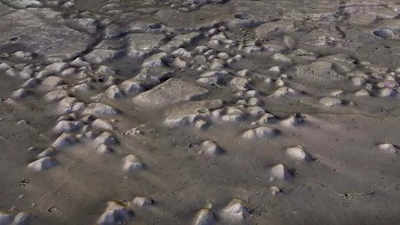- News
- Science News
- Did Mars once have a massive ocean? New study suggests ancient ocean in Martian clay mounds
Did Mars once have a massive ocean? New study suggests ancient ocean in Martian clay mounds
Discoveries of clay minerals in Martian mounds by researchers indicate that Mars once had large bodies of water billions of years ago. This finding, exhibiting a radically different climate during Mars' Noachian era, boosts chances of ancient life and lays the groundwork for the future Rosalind Franklin rover mission exploring potential life signs.
Thousands of hills and mounds on Mars contain clay minerals that were formed when water interacted with the planet's surface billions of years ago. This discovery provides further evidence that Mars once had large bodies of water, which means the planet would have been much warmer and wetter much of its lifetime.
The study leader, Joe McNeil of the Natural History Museum in London, said it was a great find, as this discovery shows a radically different climate on Mars in the distant past. The fact that clay minerals are present on the planet implies that liquid water must have flowed on the surface nearly four billion years ago, specifically in the northern regions of Mars, which researchers believe were flooded at that time.
Mars has divided the landscape of this planet into two very distinctive regions: old, ancient highlands located in the south of Mars and low-lying plains occupying much of the northern hemisphere. Many believe these low-lying plains were once host to giant lakes, rivers, or possibly oceans. Accumulating evidence increases the idea that Mars must have been much more wet a place during the initial years of the history of Mars.
Study of Martian mounds reveals evidence of water on ancient Mars
The mounds are the leftovers of a prehistorical highland region, eroded millions of years by wind as well as water, leaving only mesas and buttes. These are like other desert-type regions that occur on Earth and compare easily to the western part of the United States. NASA's Viking 1 in 1976 landed on such a vast lowland region known as Chryse Planitia.
Clay minerals point to a wet period on Mars during the Noachian era
The minerals are clay ones, and hence they must have been formed due to a significant wet period referred to as Noachian during the history of Mars. According to the results, this phase took place at 4.2 to 3.7 billion years ago when liquid water can be said to have been prominent on the surface of Mars. Their presence is related to the way water interacts with rock over a lot of time so that clay forms.
Curiously, the underlying and overlying rocks do not have clay, and hence, these clay layers appear to be an equivalent of some wet period in the distant past of Mars. This discovery would go a long way in the study of hydrology of the planet and how such ancient water may have existed on Mars.
New findings set the stage for Rosalind Franklin rover's search for past life on Mars
These results are significant in terms of implications for the next missions to Mars. One of these missions is the European Space Agency's Rosalind Franklin rover, scheduled to launch in 2028. The rover will explore the nearby Oxia Planum, which is geologically connected to the region where the clay-bearing mounds were discovered. This region is one of the best areas to look for past life on Mars, as it may offer the best opportunity to find evidence of ancient Martian organisms.
These new findings, published in Nature Geoscience on January 20, underscore the continued relevance of studying Mars' past to learn more about the history of the planet, its potential to harbor life, and human exploration of the planet in the future.
Also Read | “The largest human gathering in the world is well lit”: NASA astronaut reveals breathtaking images of Maha Kumbh Mela from space
End of Article
FOLLOW US ON SOCIAL MEDIA
Hot Picks
TOP TRENDING
Explore Every Corner
Across The Globe












